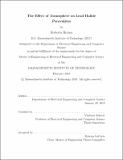The effect of atmosphere on lead halide perovskites
Author(s)
Brenes, Roberto(Scientist in electrical engineering and computer science)Massachusetts Institute of Technology.
Download1102055527-MIT.pdf (30.05Mb)
Other Contributors
Massachusetts Institute of Technology. Department of Electrical Engineering and Computer Science.
Advisor
Vladimir Bulović.
Terms of use
Metadata
Show full item recordAbstract
Metal halide perovskites are exciting materials for low-cost optoelectronic devices such as solar cells and LEDs. At present, perovskite materials still suffer from substantial non-radiative decay, particularly under solar illumination conditions, and are therefore yet to reach their full potential. In this thesis, we demonstrate the use of light and atmospheric treatments on polycrystalline perovskite films, resulting in minimal non-radiative losses and properties approaching those of perovskite single crystals and even the best crystalline semiconductors reported to date. We show that by combining light and atmospheric treatments, we can increase the internal luminescence quantum efficiencies of polycrystalline perovskite films from 1% to 89%, with carrier lifetimes of 32 [mu]s and diffusion lengths of 77 [mu]m, comparable with perovskite single crystals. Remarkably, the surface recombination velocity of holes in the treated films is 0.4 cm/s, approaching the values for passivated crystalline silicon, which has the lowest values for any semiconductor to date. The enhancements translate to solar cell power-conversion efficiencies of 19.2%, with a near-instant rise to stabilized power output, consistent with suppression of ion migration. Also, we use in-situ microphotoluminescence measurements to elucidate the impact of light-soaking individual methylammonium lead iodide grains while immersing them with different atmospheric environments. We show that emission from each grain depends sensitively on both the environment and the nature of the specific grain, i.e., whether it shows good (bright grain) or poor (dark grain) luminescence properties. We find that the dark grains show substantial rises in emission, while bright grain emission is steady when illuminated in the presence of oxygen and/or water molecules. We find that oxygen molecules bind particularly strongly to surface iodide vacancies which, in the presence of photoexcited electrons, lead to efficient passivation of the carrier trap states that arise from these vacancies. This thesis reveals a unique insight into the nature of nonradiative decay and the impact of atmospheric passivation on the macro- and micro-scale properties of perovskite films.
Description
This electronic version was submitted by the student author. The certified thesis is available in the Institute Archives and Special Collections. Thesis: M. Eng., Massachusetts Institute of Technology, Department of Electrical Engineering and Computer Science, 2019 Cataloged from student-submitted PDF version of thesis. Includes bibliographical references (pages 123-133).
Date issued
2019Department
Massachusetts Institute of Technology. Department of Electrical Engineering and Computer SciencePublisher
Massachusetts Institute of Technology
Keywords
Electrical Engineering and Computer Science.